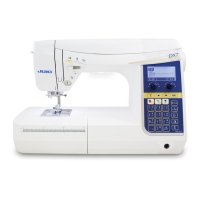– 3 –
[2] Search by trouble (related to mechanical components)
Phenomenon Item to be checked
Faulty thread tension 6-8: Position of the hook rotation stopper plate
6-9: Adjusting the bobbin thread tension
6-10-2: Pretension disk opening amount
6-10-3: Tension disk opening amount
6-10-4: Base tension opening amount
6-11: Adjusting the needle thread tension
Stitch skipping 6-1: Adjusting the needle bar height
6-2: Adjusting the needle entry point
6-5: Feed timing
6-6: Timing between the needle and the hook
6-7: Clearance between the needle and the blade point of hook
Thread breakage 6-1: Adjusting the needle bar height
6-6: Timing between the needle and the hook
6-8: Position of the hook rotation stopper plate
Hitch stitch 6-2: Adjusting the needle entry point
Faulty material feed 6-3: Feed dog height
6-15: Adjusting the presser bar height
Contact between needle and throat plate
or hook
6-2: Adjusting the needle entry point
6-5: Feed timing
6-6: Timing between the needle and the hook
Faulty pattern shape 6-3: Feed dog height
6-18: Longitudinal feed
Faulty automatic thread trimming 6-17-1: Lateral position of the thread trimming mechanism base
6-17-2: Phase of the catching unit driving cam
6-17-3: Replacing the thread trimming blade
Faulty operating noise 6-4: Timing belt
6-16: Motor belt
Needle threader 6-12: Vertical position of the needle threading hook
Fails to start sewing 6-20-1: Auto-lifter cam lever
6-20-3: Adjusting the height of the presser foot when it is lifted
Faulty automatic presser foot lifting height 6-19: Knee lifting wire
6-20-1: Auto-lifter cam lever
6-20-2: Presser-lifter position sensor
6-20-3: Adjusting the height of the presser foot when it is lifted
Straight stitch slide plate 6-21-1: Adjusting the position of the straight stitch slide plate
6-21-2: Straight stitch slide plate sensor PCB

